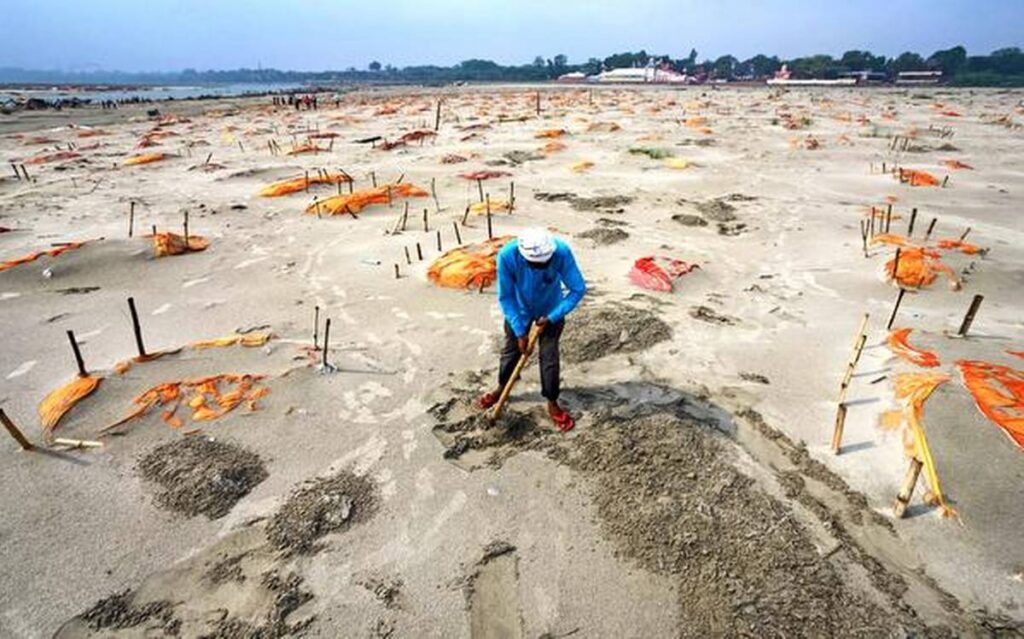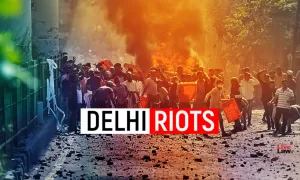The ghats of Varanasi were overwhelmed by an unprecedented number of cremations and even sand burials in April-May during the devastating second wave of COVID-19. A local veteran boatman said that he had not seen such sand burials earlier and that they had more to do with lack of money than religious belief.
Back in 2017, when Prime Minister Narendra Modi indulged in “shamshan-kabristan” (cremation ground-graveyard) rhetoric at an election rally in Fatehpur, Uttar Pradesh, little would he have known that his words would return to haunt him. Every day, in the wee hours, smoke from mass funerals fills the dark skies of Varanasi, the Prime Minister’s constituency, which has been brought to a standstill by a raging pandemic. The common man has been stripped of dignity in death, with many bodies given a hurried sand burial, while others are immersed in the Ganga with just a prayer.
As the senior priest Pandit Deepak Malviya reveals: “Though things improved in mid May, April was a tragic month. There was no space to cremate the dead. Wherever one looked, there was just fire from the pyres. It was difficult even to breathe.” The estimates of casualties range from a scarcely believable nine a day according to State officials to a more credible 686 on one day, as quoted by those with an ear to the ghats of Varanasi.
Either way, the city where thousands come seeking moksha (salvation) has been swamped by deaths in the second surge of COVID-19. From end March, when COVID-19 casualties started showing an upward trend across the country, to early May, Varanasi has had to accommodate more dead than the powers that be are ready to admit.
Manikarnika ghat and Harishchandra ghat are the two main sites of cremation. According to Pawan Chowdhury, a dom (the keeper of the fire that lights the pyre): “In normal circumstances, we get about 15 bodies a day at Harishchandra Ghat. In mid May, we came back to around that figure, or maybe 20 bodies or so a day. In April, I am told, it was more.” He refused to comment on how much more, as doms are apparently under pressure not to give interviews to the media or talk of the dead even on social media.
Pandit Deepak Malviya, though, admits that the ghats of Varanasi saw unprecedented scenes of death at the height of the pandemic. He said: “Things are better in May. In April, things went beyond control. At that time, there was no place available to cremate the dead. Every day, there were 200-300 bodies at the ghats. Mostly, these were either local bodies or from the areas close to Varanasi. I personally do not supervise the rituals at the ghats for anybody as I am attached to some yajmans [clients]. I do may be one or two cremations a month in normal circumstances. At times, none at all in a month. However, since April 10 to about May 15, I have done the last rites for about 20 bodies. So, yes, in comparison to one or two a month, 20 is much higher. I must add the pandemic is for real. It is claiming the lives of not just the old but the young, too. In the family of one of my yajmans, there were four casualties in eight days. One was 70 years old, the other 65, another was 42, the fourth one was only 34. It is the first time I have seen such a calamity.”
The numbers were so overwhelming that authorities had to open two more cremation sites owing to high numbers at the Manikarnika and Harishchandra ghats. Pandit Deepak Malviya said: “The municipal authorities opened Saamne Ghat so that the bodies from out of the city do not come to Banaras proper.” This is seconded by Sanjay Sahni (name changed on request), a boatman, who said: “The number of bodies came down in May. But at least partially it was because the authorities ruled that bodies from other cities could not come in. If you do not allow the families to bring the dead to the ghat, then the figures will automatically go down. They also earmarked Saamne ghat to take care of COVID cases, but it was only for those who died in hospitals. The bodies of those who died at home could be taken to any ghat. In April, there were 300-400 deaths at Harishchandra ghat itself. People had to wait for five or six hours for cremation. At times, when a body was burnt but the ashes were still smouldering, another pyre was put on top of that because the wait was just unbearable. Many others chose instead to give a water burial. The bodies later washed ashore. Just the other day, a body was discovered on the river bank. The authorities sent it to the other shore and gave it a quick sand burial. The officials just try to wash their hands of, try to ensure that the body somehow reaches another official’s territory.”
Besides the Saamne ghat, there is a provision to cremate bodies at Sarveshwari Samuh ghat. Gaurav Kapoor, a Congress leader based in the city, said: “They have an aghori priest at Padao, at Sarveshwari Samuh ghat opposite Rajghat. Earlier, one body used to burn there every 15-20 days. But in April on an average, 30-40 bodies were burnt at the ghat. Now, it would be around 15-20 there. The authorities opened up new ghats as one way to bring down the numbers. At Padao you cannot even click a picture.” He added: “The aghori priests are not objecting. They understand there is a crisis. We are all suffering. We have all lost our loved ones.”
The noted artist Latika Katt, who has a studio facing one of the ghats, said: “Every morning around 4 a.m., a vehicle comes to dump bodies. Often, I am told, there are 15-20 bodies in the vehicle. The bodies that arrive very early in the morning would probably have been put in a ditch. Otherwise, why bring them in a dumper and not another vehicle? We will know only during the monsoons.” The security guard at Latika Katt’s studio claimed: “The bodies keep coming the whole day till midnight.” However, Latika Katt agrees with Pandit Deepak Malviya that the number of bodies coming for cremation decreased around mid May. She said: “It is a pandemic. There is no management, nothing, in Varanasi. Everything, as the court said, is Ram bharose (at God’s mercy).”
In Varanasi, incidentally, many bodies come from the neighbouring towns and villages of eastern Uttar Pradesh, even Bihar. Also, those families from towns in the vicinity who bring their family members for treatment to Banaras Hindu University hospital or any other hospital, do not take the bodies home after death, and prefer to cremate them in Varanasi itself. As a mallah (boatman) revealed on condition of anonymity: “Some family members are too scared to even stand close to the body of a person who dies of COVID. They just leave the body unclaimed.” It is probably these bodies that were brought to the river bank by a dumper, as Latika Katt revealed.
Gaurav Kapoor said: “On May 21, 285 bodies were burnt. They were wrapped in the kit the hospitals use for COVID mortalities, so they had to be COVID cases. But only six were officially declared. There were days when some 700 bodies were cremated at Manikarnika and Harishchandra ghats alone. There were days when official numbers were 13 to 16, but the actual numbers were between 500 and 700 between April 10 to end April. Most were likely to be from Varanasi and adjoining districts as people cannot travel so easily in these COVID times. There is no written rule against bringing the dead to Varanasi, but cops often ask the villagers to take the body back, or to take it to a ghat off the main city.”
Sand burials
There is a controversy around thousands of sand burials on the banks of the Ganga. While some bodies may have washed ashore following a water burial, most look like they were hurriedly buried in shallow sand pits. However, the bodies were later exposed to the elements in many cases. Pandit Deepak Malviya claims that people in villages around Varanasi believe that no rites should be performed during “Panchat” (a period of five days in a year). “So instead of performing the last rites, they buried the bodies in the sand or just left them in the river.”
But was it not true that not everybody could afford the skyrocketing expenses involved in last rites at a such a time? Privately, people talk of Rs.25,000 or even Rs.30,000 being charged in the city. Pandit Deepak Malviya said: “I do not agree. The government has fixed the rates. At Harishchandra Ghat, it is Rs.5,200 for normal deaths and Rs.7,200 for COVID deaths. There could be cases where people would have charged a higher amount, but mostly, the rates have been adhered to.”
However, the Pandit’s claim of people following belief and not cremating the dead does not find many takers. Gaurav Kapoor said: “When the first wave of COVID came last year, people somehow survived despite losing their jobs. This time, they have nothing to fall back on. People borrowed money to treat the sick. After they died, they had no money to pay for the cremation. More so, when Rs.20,000 to 30,000 was charged for cremation. People are desperate. They did not leave their dead because of any belief in panchat. They had no money. They could not afford even the Rs.5,000 for cremation.”
The local mallahs and doms, too, feel the sand burials have little to do with religious belief, and much to do with the state of the economy. The boatman Sanjay Sahni said: “I have not seen these sand graves earlier. I am almost 50 and have spent my entire life in Varanasi. This is the first time I have seen these mass burials.” As Gaurav Kapoor summed it up: “They [the authorities] have perfected the art of fascism without being Hitler. Every death has to be laid at the door of the Prime Minister. The preparation for the second coming of COVID should have been much better.” It is a sentiment shared by the bereaved as the city struggles to count its losses.
(Ziya Us Salam is a noted literary and social commentator. Article courtesy: Frontline)




